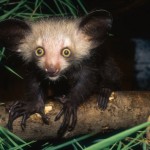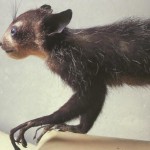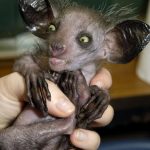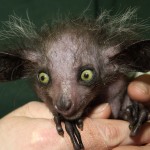The aye-aye is known as Daubentonia madagascariensis. It is a rodent like animal that can be found in Madagascar. Its features are similar to that of a rodent. The aye-aye, a type of lemur, belongs to the Daubentoniidae family. It is the sole surviving member of the genus Daubentonia.
According to the IUCN, it has been declared as near threatened species. The aye-aye might become extinct in less than 1000 years. You would be interested to know that this rodent got its binomial name, Louis-Jean-Marie Daubenton, who is a French naturalist. Since the lemur is found in Madagascar, the second name madagascariensis.
In Madagascar, the local language is Malagasy. In Malagasy, aye-aye is pronounced as hay-hay. There are other reasons about how it got its name, with one being heh heh. In Malagasy, heh heh, means, I don’t know. The actual reason for its name, aye-aye is still not confirmed. It could have either been named by the Europeans or by local people.
Appearance
Though, many of you might not find the aye-aye attractive, the rodent like animal has many takers. That is because, they have some beautiful color combinations on them, which make them the underdogs in the animal kingdom. You can find young aye-ayes coming with silver colored and black stripes on their body.
Once they grow older, the colors start to change in their body. The fur on their skin starts to grow, so you may not get them in one color. They come with dark brown color on the middle part of their body and the color white on the front part of their body. Aye-aye when full-grown is three feet long.
Their tail matches the length of their body. One of the unique features about the aye-aye is their fingers. They use their fingers for finding food and grooming themselves.
Diet
The ay-aye typically lives on fruits, fungi, seeds, nectar, and other similar foods. They like to mainly eat beetles, which it effortlessly picks up from the trees. When not in their natural habitat, they consume eggs, sugar cane, mangoes, and similar foods. Like mentioned in the earlier paragraph, they use their fingers to find food for themselves.
They make use of their third and fourth finger to find food by tapping on trees. They make holes inside the trees for their food. This method to find food is similar to the woodpecker as it uses its beak to cut through the tree for food. This is the reason the aye-aye is often compared to the woodpecker when searching for food.
Breeding
Their population has been declining annually. In North Carolina as the Duke Lemur Center, captive breeding has been taking place for many years. The Duke Lemur Center has been specializing in the breeding and research of the aye-aye. The Center has taken efforts to send their team members all the way to Madagascar to bring them in here for breeding.
Predators
Today, the aye-aye is considered as a near threatened species. Though, other bigger animals like to feed on them, they are killed mostly by human beings. Unfortunately for them, they are considered as a symbol of death. They are considered as an evil sign for the locals. However, the naturalist has found that these creatures are very fearless.
That is because they have come right up the naturalist and smelled them right at their feet. This demonstrates that the animal is courageous and deserves our sympathy.
Life Cycles & Lifestyle
At the Duke Lemur Center, research has been carried out about the life cycles and the lifestyle of the aye-aye. They are studied based on their growth and changes in their diet and lifestyle are noted. Since it looks more like a rodent due to its facial features and body characteristics, it has been classified by many in the Rodentia family or squirrel.
They come with big front teeth as a squirrel, hair color, and a large tail. The family of the aye-aye has been a long discussed topic without a proper conclusion.
Aye Aye Facts
You’ll be amazed to learn that the aye-aye can use its fingers to extract food from tree trunks. This is a very unique feature of the animal. They tap on trees a few times and, using the echoes they hear, create holes with their teeth. After creating a hole in the tree, they use their fingers to extract the food.
They usually search for their foods during the night time. They like to take occasional breaks in between their work. The aye-aye can ascend trees by making consecutive vertical leaps. You might be surprised to learn that the aye-aye can travel up to 4 kilometers each night.
Also read: Bandicoot – Facts, Habitat, Life Cycles, Diet
In the year 1933, the aye-aye was thought to be extinct, but only found out in the year 1957. In the year 1966, more than eight aye-ayes were transported from Madagascar. Though people in Madagascar kill the aye-aye due to their superstitious beliefs, being a poor island they cannot do without farmlands
Pictures, Pics, Images and Photos of Aye Aye :







Habitat
The aye-aye can be found on the coastal islands of Madagascar, especially on the East side. They like to live in the rainforest, but due to their unwanted killing by the locals, they are shifting base to farmlands. Also they like to reside in canopy areas which are at a height of more than 700 meters.
During the day, the aye-aye sleeps in nests built in trees. At night, it is actively searching for food among the trees.
Behavior
The behavior of the aye-aye is similar to that of a rodent. They walk and behave more like a rodent or squirrel. They can move fast around any territory.






